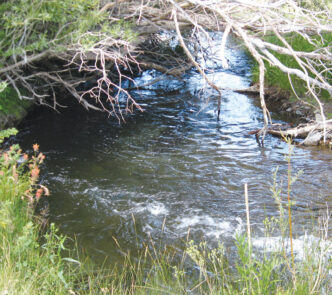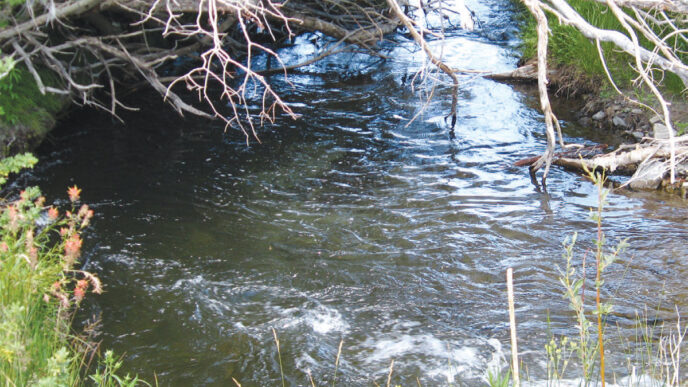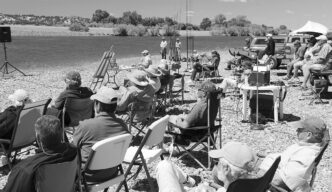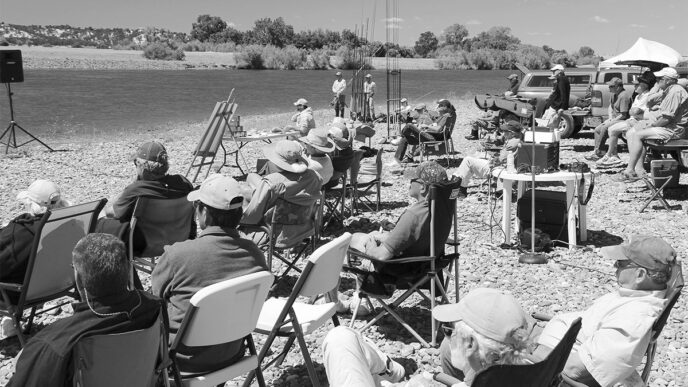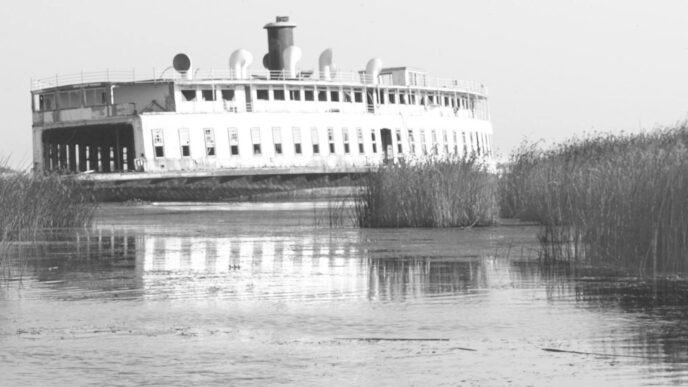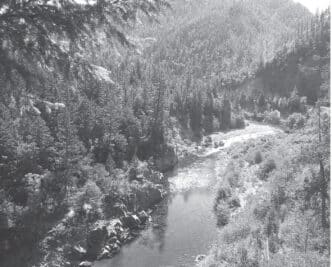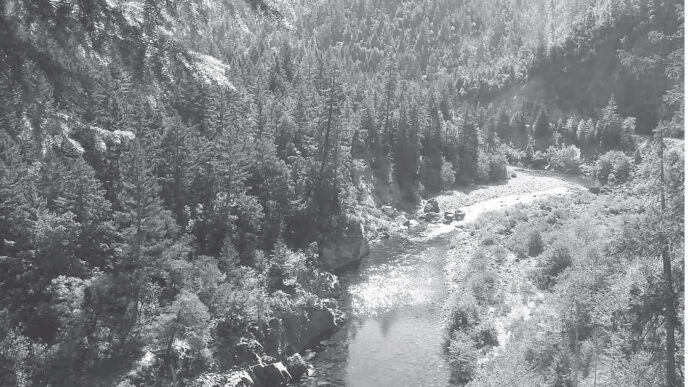This is the first of a two-part series on conservation success stories involving trout and other sport-fish waters in California. Presented below are the top 10 in Northern California, and the second part will highlight successes in Southern California.
Successful fishery conservation stories are hard to come by in California. Thirty-eight million people, plus pollution, development, despoiled watersheds, and recreational stress on lakes and streams contribute to degraded fish habitats, something that isn’t easy to correct. Successful habitat-protection and restoration projects can take years. But despite the challenges, there are success stories — and some hoped-to-be-successes — that benefit fish and fly fishers. Here are the top 10 in the northern part of the state.
1. Lake Davis. There was a recent flyfishing club outing to Lake Davis on which everyone caught trout. That’s notable, because it occurred at this previously troubled lake, which is now a genuine success story. “Lake Davis is a sweetheart — one of the best public stillwater fisheries in Northern California by far,” said fishing guide Jon Baiocchi of Nevada City, who has been fly fishing the lake since 1995. “The pike are gone. The trout cruise the shoreline and are back to grazing like cattle. With the pike, they were very leery about coming in and being ambushed.”
“Grazing like cattle” might be a bit of guide hyperbole, but he’s not too far off the mark in describing the healthy rainbow population in the artificially created, 46-year-old, 4,025-acre lake, located at the 5,886-foot elevation in the Plumas National Forest, about an hour north of Truckee. According to guides, anglers, and state fishery officials, the northern pike have not been seen in a long while. Either they’re gone or their numbers are so low that they don’t pose any problem for the trout population. Nervous anglers, however, are always on the lookout for telltale signs of this razor-toothed predator.
“Right now, I know of no pike,” said Baiocchi, “but this last fall, a number of fish were caught by my friends and me that had some weird scratch marks on them. I like to think it’s from birds, but the ospreys have been gone for a while.” Ospreys are known for plucking trout from lakes, but then sometimes dropping them on the way to the nest.
Anglers are still nervous because the northern pike population was the major story for years after they were discovered in the late 1990s. At the time, officials said they were illegally planted from another lake, probably in Nevada. According to the Nevada Department of Wildlife, pike populations exist in Bassett and Comins Lakes there, in numbers so high that the state halted stocking activities.
In controversial projects in 1997, state, federal, and local fishery officials used rotenone to poison Lake Davis to get rid of the voracious pike, which they feared would feast on the impoundment’s trout and baitfish, such as golden shiners, bullheads, bass, and pumpkinseeds. They were also afraid that the pike would escape and swim downstream via the Feather River into the Sacramento–San Joaquin Delta, where they would prey on the striped bass, salmon, and steelhead, endangered fish that the state has spent billions to protect. Following the rotenone treatments and implementation of other nonchemical pike eradication strategies, Eagle Lake rainbows and cutthroat and brook trout were planted in the highly productive lake, resulting in a return of the trophy trout fishery.
Without recent surveys, no one knows for sure if pike are still in the lake. Two years after the 1997 rotenone treatment, fishery biologists confirmed the presence of pike in the lake, according to the 2003 History of the Lake Davis Fishery and Management,a report by the California Department of Fish and Game, which has been recently renamed California Department of Fish and Wildlife. “Angler survey data indicated that the fishery is still troubled, and managers face more very difficult decisions in the future,” said the report. Now, however, 10 years later, state fish managers are apparently comfortable with the health of the lake. They recently successfully petitioned the state Fish and Game Commission to remove the special fishing requirement that any pike caught must be killed and not returned to the lake. Baiocchi said it’s been a “banner year” for hatches of damselflies, chironomids, including large blood midges, Callibaetis mayflies, dragonflies, backswimmers, leeches, scuds, and also for the Hexagenia mayfly, which has never been in the lake before. All this signals that biological health is returning to the lake. “The most important thing this year is the appearance of the snails,” said Baiocchi, adding this should mean a successful future for the lake and for anglers fishing the lake next summer.
2. The Upper Sacramento River. This once-beleaguered river has undergone a successful recovery following a devastating chemical spill in July 1991 near Dunsmuir. The spill was the result of a train derailment that dumped 19,500 gallons of the pesticide metam sodium into the river, resulting in a green glob that traveled 45 miles downriver, killing all aquatic life. According to agency officials, more than one million fish were killed, including around one hundred thousand rainbow trout. The chemical even killed trees along the riverbank. News stories revealed that the train crew had no idea they were hauling a dangerous chemical.
Today, the spill is remembered by fewer and fewer anglers. Most know the upper Sacramento as a prime freestone fishing destination that enjoys easy access from Interstate 5. “Rainbow trout are the predominant fish in these waters, and most are healthy, wild, and native to the river system,” says a description of the river by The Fly Shop of Redding. “They are full of fight and often go straight up in the air when they feel the prick of a fly on their lip.”
In addition to the successfully restored fishery, the penalty and mitigation funds generated by the spill resulted in creation of a successful education program run by The River Exchange in Dunsmuir. See http://www.riverexchange.org.
3. The Klamath River. This river is a conservation success story in the making, mostly because wrangling over who has been killing the river abated when a draft agreement was hammered out by multiple stakeholders on how to open up big stretches by remove fish-blocking dams in California and Oregon. When implemented, removal of the dams will result in steelhead, salmon, and trout having access to 49 tributaries to the river and 420 miles of additional habitat. This success would not have happened without the participation of some 40 parties, each with a fishing, conservation, tribal, legal, economic, or public-trust interest in the river.
4. Hat Creek. This iconic trout stream is another evolving success story. In 1972, the Shasta County creek was designated the state’s first Wild Trout Management Area, but it has suffered from siltation and loss of aquatic vegetation. Habitat will likely be successfully improved in the creek, thanks to an agreement on a longterm strategy and $1 million from California Trout to finalize planning, obtain permits, and implement and monitor the watershed improvements. CalTrout received a $685,000 grant from the California Natural Resources Agency to start the work and is conducting a drive to raise the rest.
5. The Fall River. A 24.4-mile-long tributary of the Pit River, the Fall River is hardly a conservation success story, but there is hope in the future to improve degraded stream banks and manage the growth of the invasive Eurasian milfoil. At this degraded Shasta County river, restoration advocates and scientists at the University of California–Davis have had a major breakthrough when their tagging program showed the river has three distinct subspecies of rainbow trout, all spawning at different times throughout the year. With this information, they will be able to target restoration projects at spawning areas used by the fish.
6. The Elk River. Along this river, decades of conflict ended when conservationists and an environmentally minded timber company jointly created a successful model partnership and established a process for protecting and restoring the much-abused watershed, which is located in Humboldt County two miles south of Eureka and known to anglers for its runs of chinook and coho salmon and steelhead trout.
7. The Trinity River. At 165 miles, this is the longest tributary of the Klamath River and the focal point of a decade-plus of coalition-building discussions with wildly divergent groups — discussions that are said to have been mostly successful, depending on whom you talk to and the day of the week. In the fly-fishing community, the Trinity is known as the river where fly fisher and retired Mill Valley banker Byron Leydecker was so appalled by the river’s poor condition that he started the Friends of the Trinity River. Before he died in 2011, Leydecker lobbied for 18 years for the river’s restoration. Various task forces, councils, coordinating committees, and working groups are inching toward a successful effort to do so, a task that is complicated by the rights of an Indian tribe, legal actions, a billionaire landowner, and excessive demands for the river’s water. The prospect of a successful future for the Trinity has been fleeting, but it’s not for lack of trying. See the Trinity River Restoration Project Web site at http://www.trrp.net for more information.
8. Lagunitas Creek. Thanks to work by a crew of volunteers from Trout Unlimited’s North Bay Chapter, this Marin County stream has seen a surge in salmon and trout number since restoration projects were implemented, including planting trees and willows, installing erosion barriers, blocking cattle access with fences, creating hatch boxes and rearing troughs, and releasing eggs. For more on the TU chapter’s work, see http://www.tucalifornia.org.
9. Silver King Creek. Located in tiny Alpine County in the Sierra Nevada at an elevation of 8,500 feet, this creek is the site of efforts by the California Department of Fish and Wildlife to reestablish a population of Paiute cutthroat trout, a rare fish that is listed as threatened by the federal Endangered Species Act. After weathering an unsuccessful legal challenge, state and federal wildlife officials poisoned a competing nonnative trout species that had been introduced to the creek many decades ago. For more information on this multiyear project, see http://www.dfg.ca.gov/fish/REsources/WildTrout/WT_Paiute/WT_PaiuteCutRestor.asp.
10. Suisun Marsh. While the debate over long-term plans for the Delta rages on, agencies on its west end have successfully turned the 116,000 acres of tidal estuary and farmland near Fairfield in Solano County into a haven for fish. The largest brackish-water marsh on the West Coast, the waters here offer sanctuary to 40 species of fish, including striped bass, steelhead trout, king salmon, crappies, American shad, and sturgeon. The marsh also hosts a population of Delta smelt, which is protected by the federal Endangered Species Act. The marsh has long been used for waterfowl hunting, with many private duck clubs and large areas open to the public.
For the record, the newly released Draft Environmental Impact Report/Study on the Bay Delta Conservation Plan has been one of the largest planning documents in California. It is 34,000 pages long (the executive summary is 132 pages). Before finally being adopted in 2014, the $25 billion plan could be successful in breaking another state record — the number of lawsuits filed and ballot initiatives challenging its contents. See the plan and environmental impact analysis, the schedule of 12 public hearings, and find out how to submit comments before the April 14, 2014 deadline at http://baydeltaconservationplan.com/PublicReview/PublicReviewDraftEIR-EIS.aspx.







